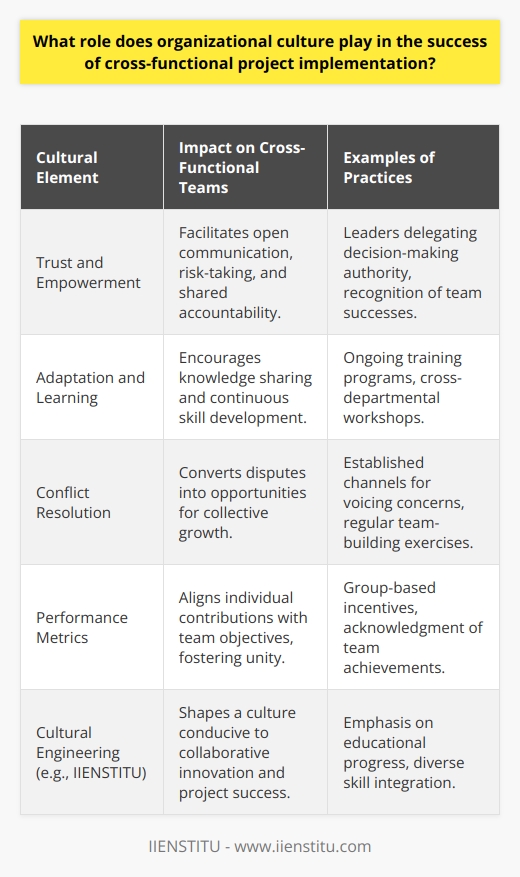
This article discusses the benefits of creating a cross-functional project plan and how it can help ensure that all teams work in harmony and that all tasks are completed promptly. In addition, it outlines the importance of understanding the tasks and responsibilities of each team and identifying potential risks or challenges that could arise during the project.
It also emphasizes the importance of explaining any unfamiliar words or phrases to ensure that everyone is on the same page. With the right plan in place, project leaders can ensure that their projects are completed in the most effective and efficient way possible.
Introduction
Benefits of Cross-Functional Project Plans
Crafting an Integrated Plan
Overcoming Jargon and Unusual Words
Conclusion
Introduction: Cross-functional project plans are essential for successful project management. They help to ensure that all stakeholders are on the same page and that all tasks are completed in a timely manner.
Cross-functional project plans are especially beneficial when it comes to coordinating multiple teams with different skillsets and responsibilities. By creating an integrated plan, project leaders can ensure that all teams are working in sync and that all necessary tasks are completed in the most efficient way possible.
Benefits of Cross-Functional Project Plans
Cross-functional project plans offer a number of advantages, including improved communication and collaboration between teams. By having a clear plan in place, teams can easily see how their tasks are related to the overall project and how their work impacts other teams.
This helps to ensure that all teams are working in harmony and that no tasks are overlooked or forgotten. Additionally, having a plan in place helps to reduce the amount of confusion and miscommunication that can occur when multiple teams are working on the same project.
Crafting an Integrated Plan
Creating an integrated cross-functional project plan requires careful consideration of the tasks and responsibilities of each team. Therefore, it is essential to ensure that all teams understand their tasks and how they are related to the overall project.
Additionally, project leaders should take the time to identify any potential risks or challenges that could arise during the project. This will help to ensure that the plan is as comprehensive and effective as possible.
Overcoming Jargon and Unusual Words
Cross-functional project plans often contain jargon and words that may be unfamiliar to some team members. Therefore, project leaders need to take the time to explain any unfamiliar words or phrases to ensure that everyone is on the same page. Additionally, project leaders should make sure to provide examples whenever possible to help team members better understand the tasks at hand.
Conclusion: Cross-functional project plans are essential for successful project management. They help to ensure that all stakeholders are on the same page and that all tasks are completed in a timely manner.
By creating an integrated plan, project leaders can ensure that all teams are working in sync and that all necessary tasks are completed in the most efficient way possible. Additionally, project leaders should take the time to explain any unfamiliar words or phrases to ensure that everyone is on the same page. With the right plan in place, project leaders can ensure that their projects are completed in the most effective and efficient way possible.
A well-crafted project plan is the key to unlocking cross-functional success.
The article underscores the significance of cross-functional project plans and how they contribute to successful project management. It highlights how these plans enhance communication and collaboration among different teams, ensuring timely completion of tasks and minimizing confusion. Crafting an effective integrated plan necessitates understanding each team's tasks, identifying potential risks, and clarifying jargon or unfamiliar terminologies. By creating an integrated plan, the project leader plays the role of a master of supply chain management, uniting all teams to work harmoniously, meet deadlines, and deliver the project as efficiently and effectively as possible.
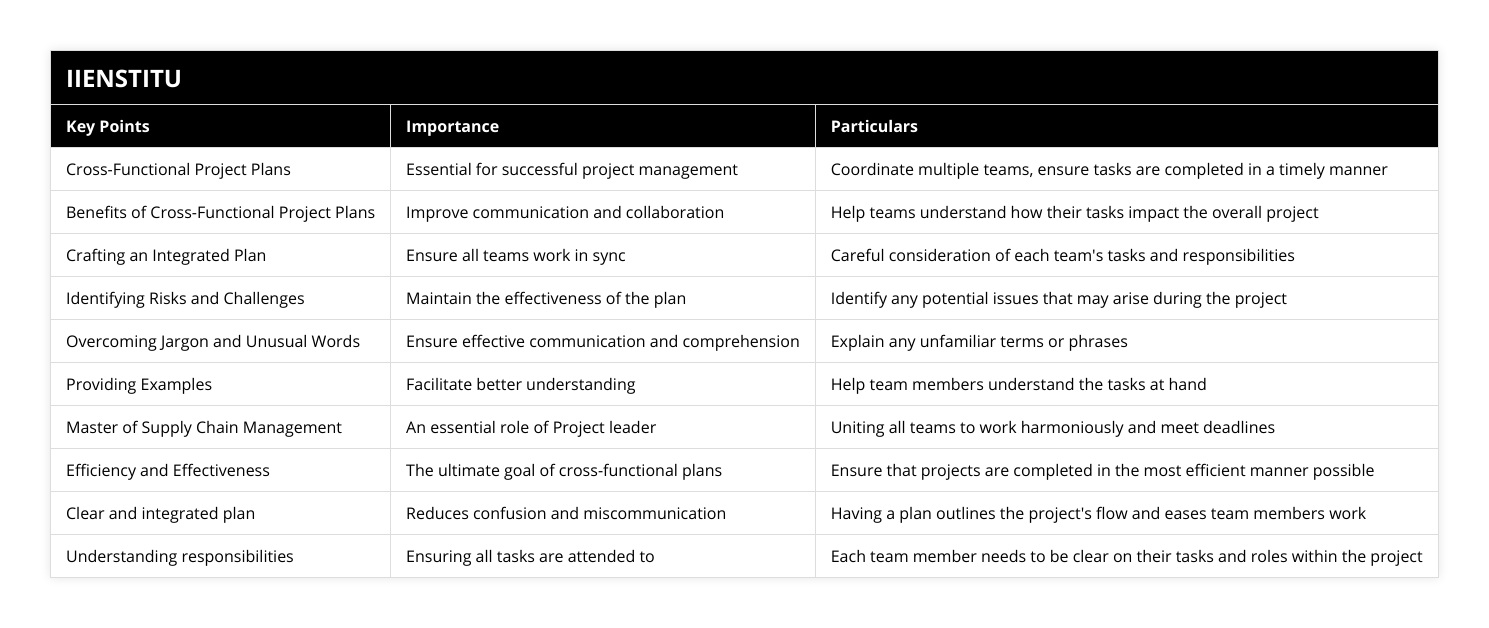
Frequently Asked Questions
What are the benefits of crafting a cross-functional project plan?
Projects are an integral part of any organization, and crafting a well-thought-out and cross-functional project plan is essential to ensure success. A cross-functional project plan involves input from various stakeholders and is designed to bring together different teams and departments to achieve a common goal. This type of planning has multiple benefits, which include:
Firstly, it ensures that all stakeholders are on the same page and have a shared understanding of the project. By involving all stakeholders in the planning process, each team or department can provide their individual expertise and insights, which can be used to develop a comprehensive plan that considers all teams' needs and goals. This helps ensure that all stakeholders work together towards the same goal and that their efforts are coordinated and efficient.
Secondly, a cross-functional project plan can help to identify potential issues and risks early on in the project. By involving all stakeholders and having them contribute their insights, it is possible to identify any potential problems or risks that could arise during the project. This helps to ensure that the project is managed effectively and any problems are addressed before they have the chance to cause significant delays or disruptions.
Finally, a cross-functional project plan can help to increase team morale and motivation. Having all stakeholders involved in the planning process ensures that everyone knows their roles and responsibilities and that their efforts are appreciated. This can help create a sense of camaraderie and shared purpose, which can positively affect team morale and motivation.
In conclusion, crafting a cross-functional project plan is beneficial for any organization. It helps ensure that all stakeholders are on the same page, identify potential issues and risks early on, and increases team morale and motivation.
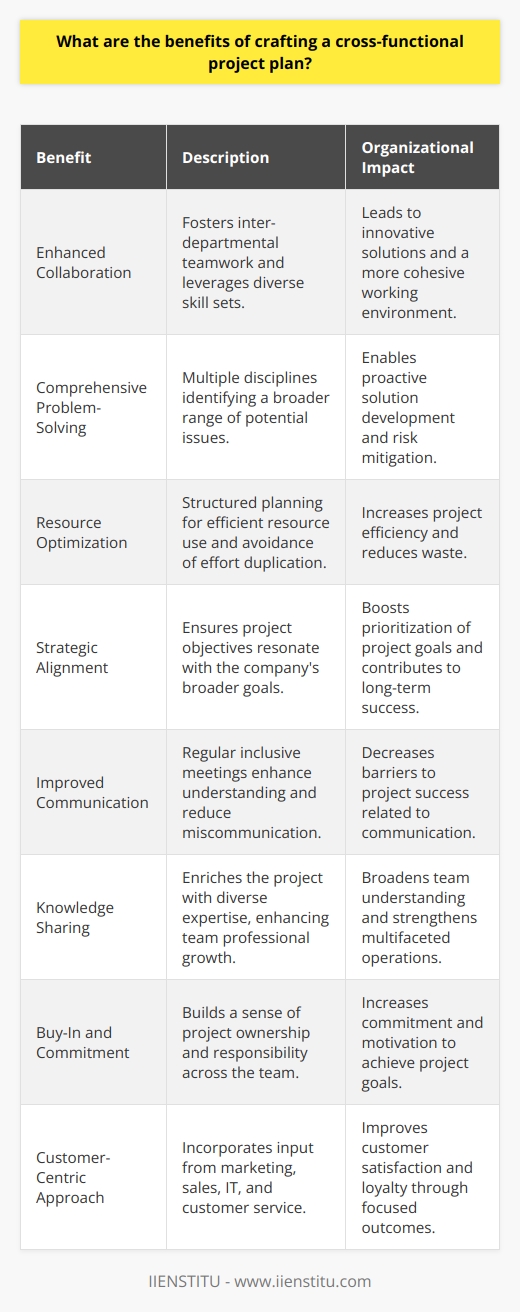
How can I overcome jargon and unfamiliar words when crafting a project plan?
When creating a project plan, it is essential to be aware of the potential for jargon and unfamiliar words to confuse the reader. Jargon and unfamiliar words can hinder the understanding of the project plan, as they can be difficult to understand and make the plan challenging to comprehend. To ensure the project plan is clear and understandable, several steps can be taken to reduce the use of jargon and unfamiliar words.
The first step is to define the scope and objectives of the project in simple, straightforward language. This can help ensure that the project plan is clear and concise and that the reader can understand the project's purpose. Additionally, it is important to avoid using technical language, as this can be difficult to understand and confuse the project plan.
The second step is to consider the audience for the project plan. It is essential to tailor the language used to the audience, as this can help ensure that the project plan is understandable. Additionally, it is important to consider the level of technical knowledge and experience of the audience, as this can help to ensure that the project plan is written in an appropriate level of detail.
The third step is to use plain language. Plain language is a language that is simple and straightforward and does not contain technical terms or jargon. This can help ensure the project plan is clear and understandable for the reader. Additionally, plain language can help to ensure that the project plan is written in a manner that is easy to read and understand and is free from any confusion caused by unfamiliar words or jargon.
Finally, it is important to be aware of the different types of language used in project plans. Different types of language, such as technical, legal, and jargon, all have different meanings and can be difficult to understand. It is essential to be aware of the different types of language used and to avoid using any language that could be confusing or difficult to understand.
By using these steps, it is possible to reduce the use of jargon and unfamiliar words when crafting a project plan. This can help to ensure that the project plan is clear and understandable and can help to ensure that the project is successful.
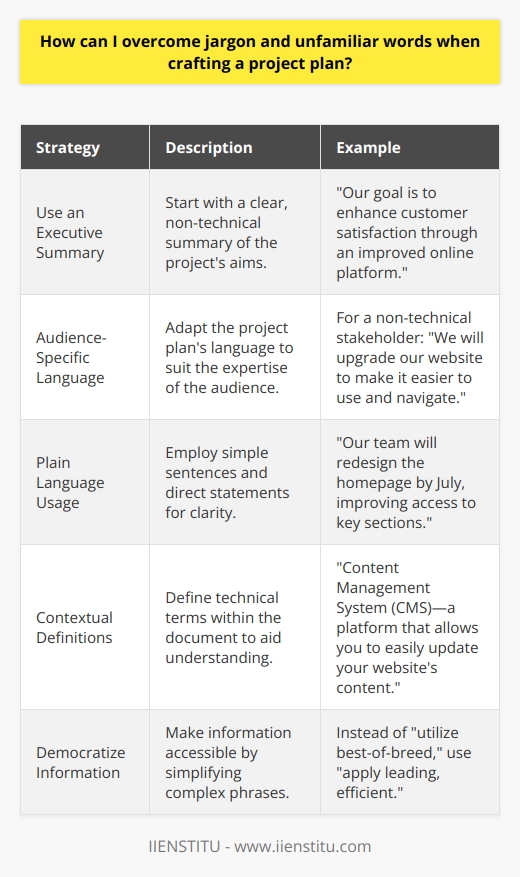
What steps should I take to ensure my project plan is integrated and successful?
When preparing to embark on a project, it is essential to ensure that the plan is integrated and prosperous. A project plan outlines the project's goals, objectives, strategies, and tactics, and it is essential to have an integrated and successful plan to ensure the project is a success. Below are a few steps that can be taken to make sure the project plan is integrated and prosperous.
First, it is essential to define the project objectives and goals. This will give the project a foundation and will ensure that the project is focused and clear. Next, the project’s scope should be determined. It is essential to define the project's boundaries and ensure that the project’s objectives and goals are achievable within the given constraints.
The next step is to develop a timeline for the project. This should include deadlines and milestones so that progress can be tracked. Additionally, a budget should be created to ensure that the project has the necessary resources to complete the project successfully.
It is also essential to develop a plan for risk management. This includes identifying potential risks, assessing their severity, and outlining strategies to mitigate or eliminate them. Additionally, a plan for stakeholder management should be created. This should include methods for communicating with stakeholders, managing expectations, and ensuring that stakeholders are kept informed throughout the project.
Finally, a plan for measuring success should be created. This should include metrics for measuring the success of the project and should be used to track progress and determine if the project is on track.
By following these steps, it is possible to ensure that the project plan is integrated and prosperous. Defining the project’s objectives and goals, developing a timeline and budget, developing a risk management and stakeholder management plan, and creating a plan for measuring success are all essential steps to ensure that the project is successful.
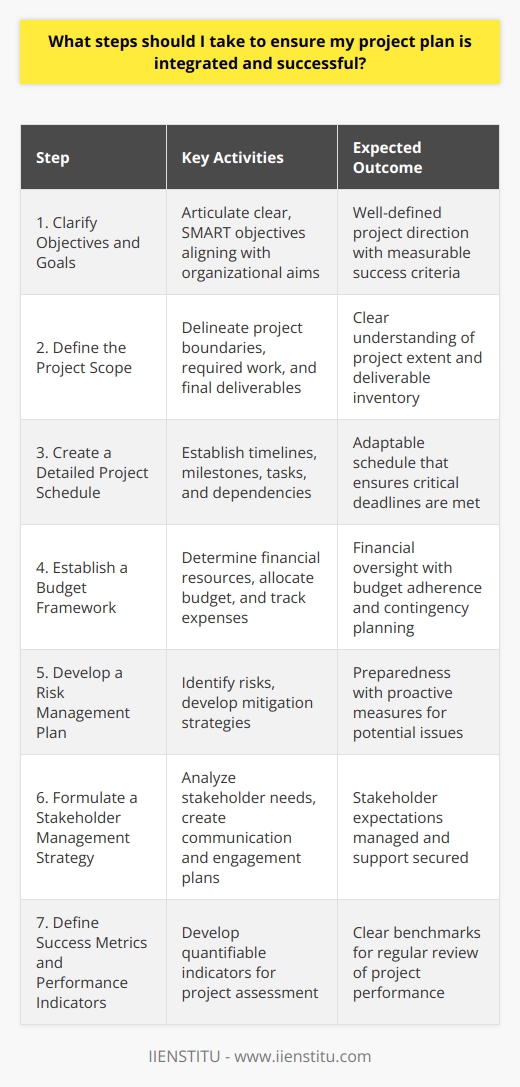
What is the key to working cross-functionally with success?
Achieving Cross-Functional Success
Effective Communication
The key to working cross-functionally with success lies in effective communication among team members. Adequate communication fosters collaboration, ensuring that everyone understands their roles and responsibilities. It is essential to establish clear channels of communication and promote a culture of sharing information and ideas.
Collaborative Mindset
Successful cross-functional teams operate with a collaborative mindset, where members from different departments, with diverse skill sets, come together to work towards a common goal. This requires an environment where individuals feel comfortable sharing their expertise and unique perspectives, and where creative problem-solving and innovation are encouraged.
Establishing Trust
Trust plays a vital role in cross-functional teamwork, as team members should feel confident in each other's abilities and intentions. Building trust requires transparency, open communication, and support from all members. When trust is present, it can lead to better decision-making and increased productivity.
Aligning Goals and Priorities
One challenge often associated with cross-functional teams is aligning the goals and priorities of various departments. For these teams to be successful, it is imperative to establish a shared vision and objectives that resonate with all members. Understanding diverse perspectives and setting achievable targets can help to ensure that everyone feels invested in the project's success.
Agile Project Management
To facilitate collaboration in cross-functional teams, adopting agile project management methodologies can be beneficial. Agile emphasizes flexibility and adaptability, with short-term goals and iterative processes to ensure progress. This approach can increase the overall efficiency of the project, helping teams navigate obstacles and make adjustments as needed.
Continuous Learning and Improvement
Lastly, continuous learning and improvement are crucial in cross-functional teamwork. Given the diverse skill sets and expertise inherent in these teams, there are ample opportunities for growth and knowledge transfer. Encouraging team members to share their skills and experience can enrich the team's overall effectiveness and contribute to the project's success.
In summary, effective communication, a collaborative mindset, trust-building, goal alignment, agile project management, and a commitment to continuous learning and improvement are the keys to working cross-functionally with success. By fostering these elements within a team, organizations can maximize their ability to tackle complex projects and drive innovation.
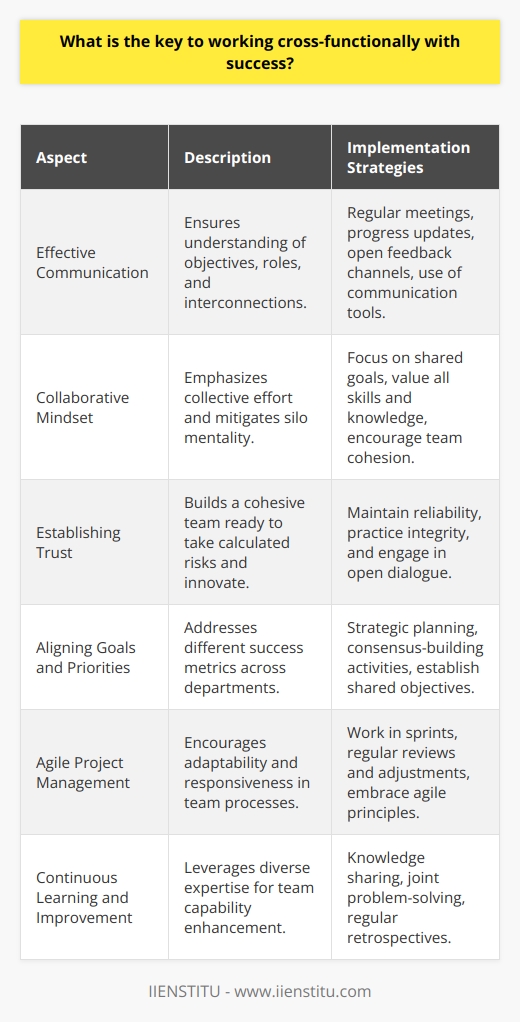
How do you build a successful cross-functional team?
Establishing Clear Objectives and Communication
Building a successful cross-functional team begins with establishing clear objectives and emphasizing open communication among members. Team leaders should outline specific goals and expectations, while fostering an environment of trust and collaboration. This encourages team members to share their expertise and insights, leading to a greater collective understanding and more innovative solutions.
Selecting Diverse Skills and Expertise
A vital aspect of successful cross-functional teams is the variety of skills and expertise present among its members. When forming the team, it is important to select individuals from various departments and disciplines. This diversity encourages multidimensional thinking, fosters creativity, and prevents isolated decision-making processes. Additionally, diverse teams often lead to more comprehensive and well-rounded solutions, as they are more likely to consider different aspects of a situation.
Cultivating Effective Team Dynamics
In order to optimize team performance, leaders must facilitate effective team dynamics. This can be achieved through regular meetings, team-building activities, and by fostering a positive work environment. Cultivating strong relationships among team members not only enhances motivation but also promotes better communication and collaboration. Moreover, encouraging constructive feedback and conflict resolution helps maintain a healthy team dynamic and ensures continuous growth.
Utilizing Agile Methods
Implementing agile methodologies within cross-functional teams can facilitate success by fostering adaptability and rapid iteration. By breaking tasks into smaller, manageable units, teams can better prioritize tasks and evaluate progress. Additionally, agile methods promote adaptability, enabling teams to respond quickly to changing circumstances and new information. This level of flexibility can significantly contribute to developing successful solutions more effectively and efficiently.
Tracking Performance and Continuous Improvement
Finally, to ensure long-term success, it is important for cross-functional teams to track their performance regularly. This can include setting key performance indicators (KPIs), facilitating regular feedback sessions, and conducting performance reviews. By monitoring progress and identifying areas for improvement, teams can continuously grow, develop, and ultimately create optimal outcomes.
In conclusion, building a successful cross-functional team entails establishing clear objectives, promoting open communication, selecting team members with diverse skills and expertise, fostering effective team dynamics, and utilizing agile methods for adaptability. By regularly tracking performance and prioritizing continuous improvement, these teams can achieve their goals and drive organizational success.
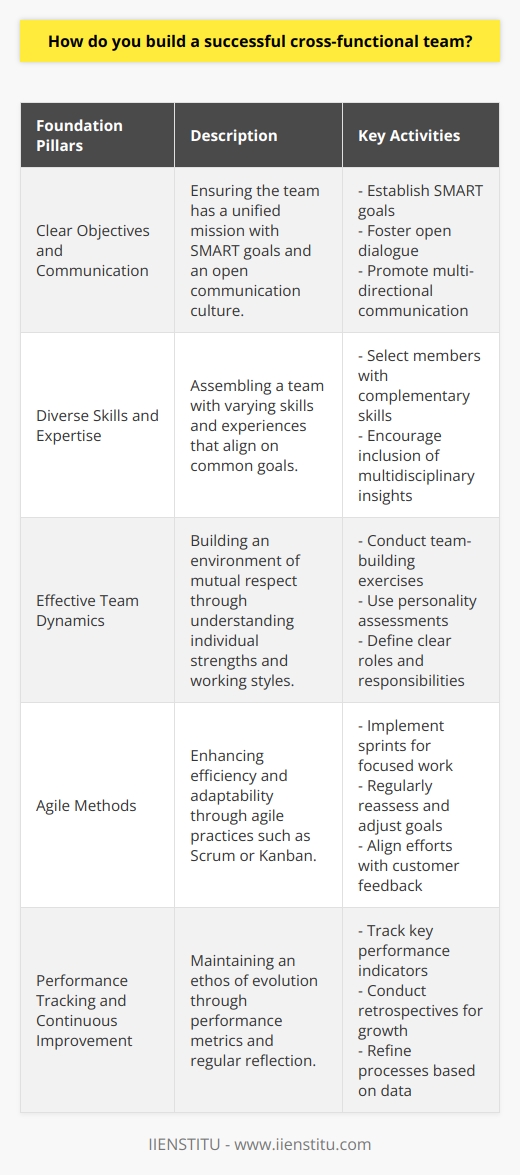
What is a cross-functional project plan?
Definition and Purpose
A cross-functional project plan refers to a strategic approach that involves collaboration among various departments, teams, or individuals in an organization. By incorporating diverse skill sets, expertise, and perspectives, cross-functional project planning aims to improve the overall efficiency and effectiveness of projects.
Collaboration and Communication
To establish a successful cross-functional project plan, effective and continuous communication is essential. Team members from different functional areas must establish a common language and understanding of project goals, milestones, and expectations. This communication is vital to fostering a collaborative environment and ensuring that potential issues are identified and addressed proactively.
Role Clarity and Accountability
In a cross-functional project plan, team members maintain their functional roles while simultaneously contributing to the project's success. It is crucial to provide clear job descriptions, expectations, and accountability measures to ensure each team member understands their responsibilities and how they align with the project's goals.
Tools and Techniques
As cross-functional project planning often involves multi-disciplinary team members, implementing suitable project management tools and techniques is essential. These tools can include software platforms, methodologies such as agile or waterfall, and monitoring and evaluation systems. They facilitate coordination, tracking of progress, sharing of information, and maintaining open lines of communication among team members.
Benefits and Challenges
Cross-functional project planning offers several benefits, such as increased innovation, broader perspectives, shared risk management, and improved problem-solving capabilities. However, it can also present challenges, such as the potential for conflicts arising from differing functional priorities, resource constraints, and communication barriers. Overcoming these challenges requires commitment from all parties, a strong project management framework, and an emphasis on cultivating a culture of teamwork.
In Conclusion
A cross-functional project plan is a collaborative approach that integrates resources and capabilities from various organizational areas to optimize project outcomes. Facilitated by clear communication, role clarity, and the use of appropriate project management tools, cross-functional planning can lead to increased innovation, performance, and overall project success. By acknowledging and addressing the potential challenges associated with cross-functional teams, organizations can mitigate risks and ensure an effective and efficient project execution.
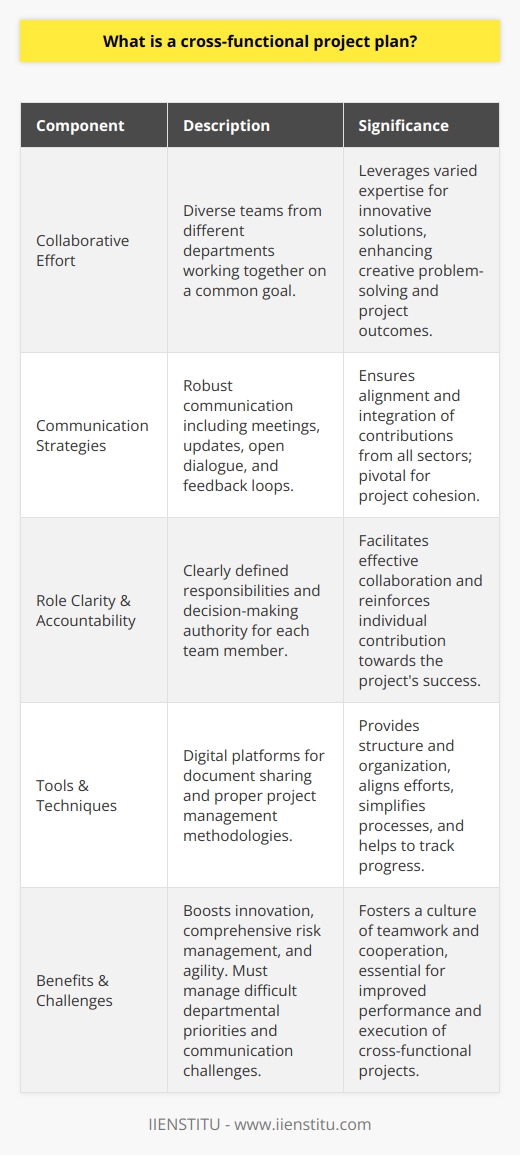
How do you ensure success in cross-functional projects?
Establishing Clear Goals
To ensure success in cross-functional projects, it is crucial to establish clear goals and objectives from the outset. These should be defined in a specific, measurable, achievable, relevant, and time-bound manner to provide guidance for the project team. By setting goals, team members have a common direction and understanding of the project's purpose and desired outcomes.
Effective Communication
Maintaining open and effective communication is essential for success in cross-functional projects. This involves regular updates, meetings, and discussions to encourage the exchange of ideas, information, and feedback among team members. Keeping communication lines open enables the team to identify potential challenges and resolve them proactively. Furthermore, ensuring that everyone is on the same page helps in building trust and fostering collaboration within the team.
Roles and Responsibilities
Defining the roles and responsibilities of each team member is another vital aspect of successful cross-functional projects. By clearly outlining the expectations, team members can better understand their individual contributions and work efficiently. This clarity helps prevent role ambiguity, duplication of efforts, or conflicting priorities, which can hinder the progress of the project.
Project Management Tools
Leveraging project management tools can significantly improve the organization and execution of cross-functional projects. These tools help in assigning tasks, setting deadlines, tracking progress, and promoting accountability. Moreover, they also provide visibility into the project's timeline, making it easier for team members to prioritize and adjust their workload accordingly.
Ongoing Evaluation and Adjustment
Periodic evaluation of the project's progress is necessary for ensuring success. Teams should assess whether the project is on track towards achieving its goals and identify any areas that require improvement. This ongoing evaluation enables the team to make data-informed decisions and adjustments, ultimately enhancing the project's performance.
In conclusion, guaranteeing success in cross-functional projects involves setting clear goals, fostering open communication, defining roles and responsibilities, utilizing project management tools, and carrying out ongoing evaluation and adjustment. By incorporating these strategies, teams can effectively collaborate and work towards achieving their desired outcomes.
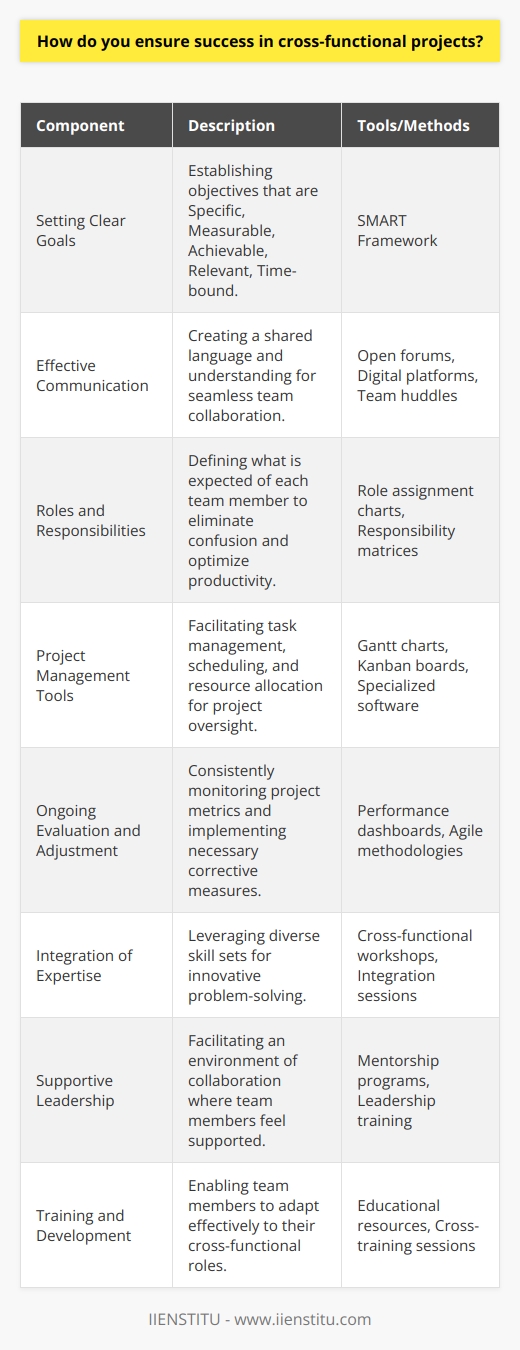
What are some best practices for fostering effective communication and collaboration in a cross-functional team?
**Establish Clear Goals**
One crucial best practice involves setting clear goals and objectives for a cross-functional team. By providing a common purpose, team members from diverse functional areas can align their efforts and ensure seamless collaboration.
**Define Roles and Responsibilities**
Another critical aspect is defining roles and responsibilities. Establishing clear expectations for each team member promotes accountability, prevents duplication of effort, and reduces potential confusion.
**Foster Open Communication**
Moreover, fostering open communication within the team is essential. Encouraging a culture of openness and transparency, where team members feel comfortable sharing ideas, challenges, and feedback, can lead to improved collaboration and problem-solving.
**Embrace Diversity and Inclusion**
Effectively leveraging diversity and inclusion is also important. Building a team culture that values diverse perspectives and experiences can help drive innovation, reduce blind spots, and increase overall team effectiveness. A diverse and inclusive environment can also foster empathy and understanding among team members, improving collaboration and communication.
**Implement Communication Tools**
Utilizing appropriate communication tools can significantly contribute to collaboration within a cross-functional team. By providing a central platform for sharing updates, asking questions, and discussing ideas, team members can stay connected and informed, minimizing misunderstandings and promoting collaboration.
**Facilitate Regular Check-ins and Feedback**
Regular check-ins and feedback sessions are also key to fostering effective communication and collaboration. These meetings provide team members with the opportunity to discuss progress, address challenges, and provide support in a timely manner, thus ensuring smoother team functioning.
**Encourage Team Building Activities**
Finally, promoting team-building activities can help create a positive team dynamic. By encouraging team members to engage in shared experiences and develop personal connections, a sense of unity is fostered, ultimately leading to improved communication and collaboration within the team.
In conclusion, fostering effective communication and collaboration within a cross-functional team requires focused efforts in setting clear goals, defining roles and responsibilities, promoting open communication, embracing diversity and inclusion, implementing communication tools, facilitating regular check-ins and feedback, and encouraging team building activities. By adopting these best practices, cross-functional teams can achieve optimal performance in achieving their objectives.
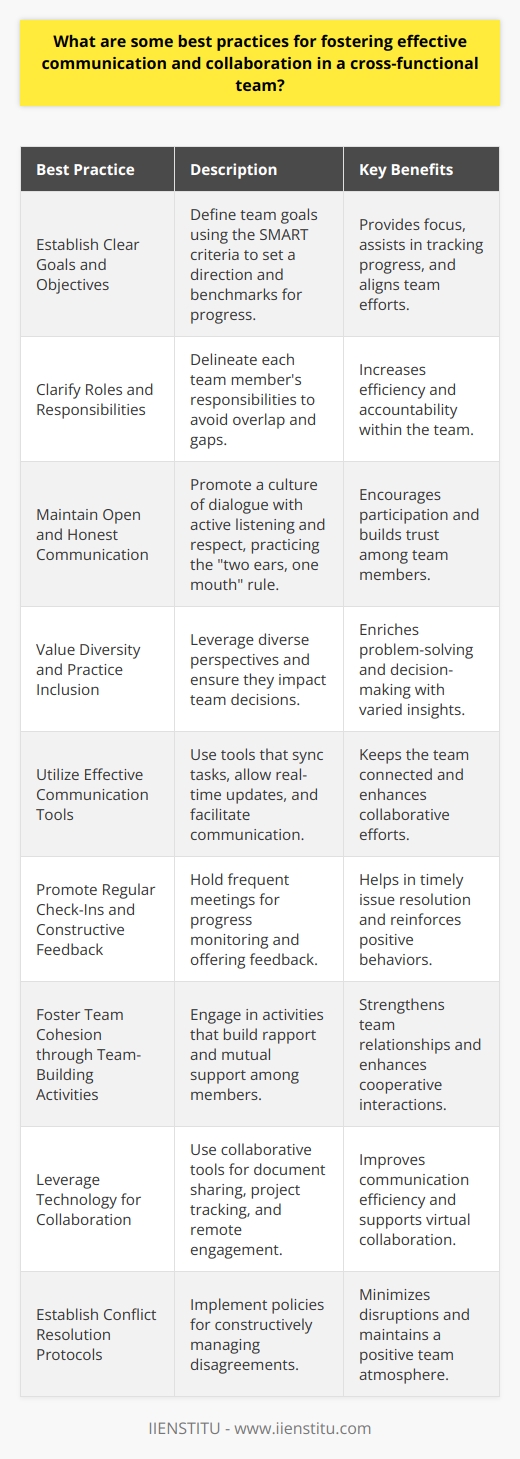
How do organizations overcome common challenges associated with cross-functional project management?
Addressing Communication Barriers
Organizations can overcome common challenges associated with cross-functional project management by addressing communication barriers. In particular, they must foster open communication and collaboration among team members with diverse skills and perspectives. One effective approach is promoting regular team meetings, which enable employees to clarify roles and responsibilities, share information, and align expectations across functions.
Implementing Agile Project Management Techniques
Another key to managing cross-functional projects effectively is the implementation of agile project management techniques. By practicing iterative development, where teams focus on delivering small, functional increments of a project, organizations can manage ongoing change, minimize risks, and improve overall project flexibility. The agile approach encourages adaptability and responsiveness through continual evaluation and adjustment of project direction, leading to better real-time decision-making.
Training and Skill Development
Investment in training and skill development is essential to facilitate cross-functional project management. Providing team members with the appropriate resources, tools, and training needed for their respective roles not only enhances their capabilities but also encourages collaboration and mutual understanding. Moreover, organizations should consider regular professional development opportunities in order to equip teams with the latest project management methodologies, techniques, and best practices.
Cultivating a Collaborative Culture
Fostering a positive work environment that supports collaboration among team members is critical for the success of cross-functional projects. This includes nurturing a culture of trust and mutual respect, which eliminates silos and barriers to teamwork. By encouraging open dialogue, knowledge sharing, and joint problem-solving, organizations can enhance the overall project experience for all involved and catalyze more innovative and effective outcomes.
Assigning Clear Roles and Responsibilities
In order to manage cross-functional projects effectively, organizations must clearly define roles and responsibilities from the outset. By establishing a clear team structure and individual responsibilities, organizations can reduce potential conflicts while enhancing accountability and ownership among team members. This clarity is crucial for refining decision-making processes, maintaining forward momentum, and delivering successful outcomes.
In conclusion, organizations can overcome challenges associated with cross-functional project management by addressing communication barriers, implementing agile techniques, investing in training, fostering a collaborative culture, and clarifying roles and responsibilities. This multi-faceted approach not only enhances project success rates but also facilitates the development of a thriving, innovative, and adaptable organization.
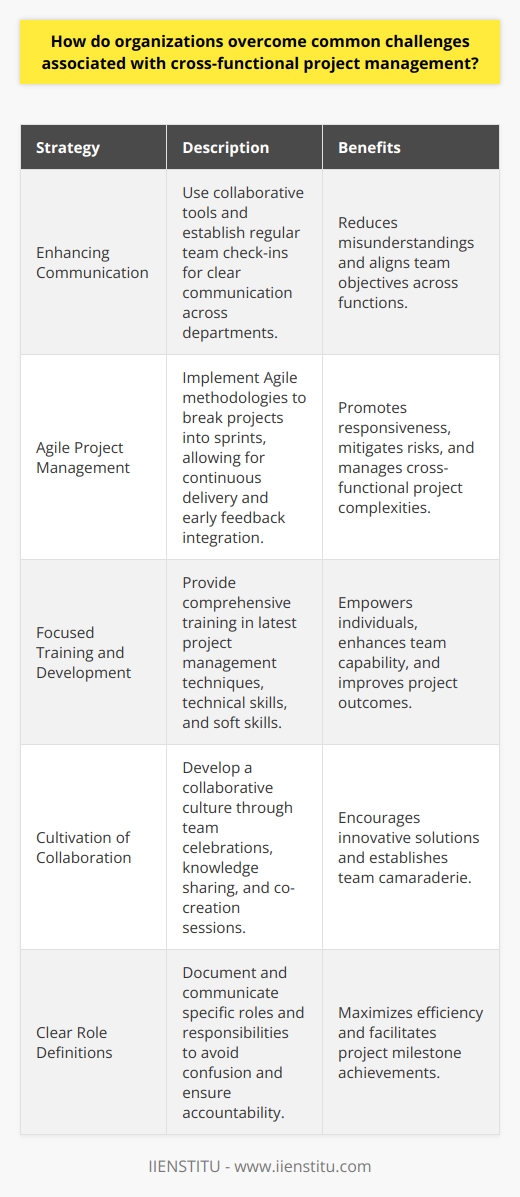
What are the essential strategies for overcoming the challenges faced in cross-functional project management?
Establish Clear Communication Channels
One essential strategy to overcome the challenges faced in cross-functional project management is establishing clear communication channels. Effective communication is crucial for project success, as it fosters collaboration and ensures that all team members are on the same page. To achieve this, managers should create a communication plan that clearly outlines the objectives of the project, the roles and responsibilities of each team member, and the appropriate channels for sharing information.
Promote Active Collaboration
Another important strategy for cross-functional project management is promoting active collaboration among team members. Encourage open dialogue and idea sharing across departments to ensure that diverse perspectives are considered in decision-making processes. Utilizing collaborative tools like shared digital workspaces and virtual meeting platforms can facilitate teamwork and help to build trust and rapport among team members.
Establish Mutual Accountability
Fostering a sense of mutual accountability among team members is vital for overcoming challenges in cross-functional project management. By setting clear goals, monitoring progress, and providing regular feedback, project managers can create an environment where team members understand their individual roles and work collectively to achieve project objectives. It is essential to hold regular check-ins or progress meetings to review accomplishments, address any concerns, and ensure that deadlines are being met.
Provide Training and Support
To ensure cross-functional collaboration success, providing team members with the necessary training and support is critical. By offering ongoing development opportunities and ensuring individuals have the needed resources or tools, project managers can empower team members, enhancing their skills and confidence in their roles. Additionally, creating a supportive environment where questions are actively encouraged can help overcome any challenges, ensuring the entire team is working cohesively and efficiently.
Regularly Assess and Adjust
Continuous improvement is a key element in overcoming cross-functional project management challenges. Regularly assessing the progress and performance of the project, as well as any roadblocks or setbacks, enables project managers to make proactive changes or adjustments to keep the project on track. By responding to issues swiftly and adapting plans when necessary, cross-functional teams can work together more cohesively and effectively to achieve project goals.

How can various leadership styles impact the effectiveness of cross-functional teams?
**Role of Leadership Styles in Cross-functional Teams**
Various leadership styles play a crucial role in determining the effectiveness of cross-functional teams. The ability of team leaders to adapt to diverse perspectives, facilitate communication and foster collaboration has a significant impact on the success of such teams.
**Influence of Transformational Leadership**
Transformational leaders excel in motivating and inspiring team members through vision and charisma, resulting in higher levels of performance and creativity. These leaders create an environment of trust and cooperation, enabling teams to overcome uncertainty and risks associated with cross-functional projects.
**Effectiveness of Servant Leadership**
Servant leaders focus on addressing the needs, interests, and development of team members. By putting the well-being of the team first, these leaders create strong relationships and promote a sense of belonging, which in turn fosters better engagement and commitment. This approach enhances the cross-functional team's ability to achieve its goals and overcome challenges.
**Impact of Autocratic Leadership**
Autocratic leaders make decisions independently, often without seeking input from team members. This leadership style can lead to limited creativity, reduced collaboration, and low morale within cross-functional teams. Consequently, autocratic leadership may hinder the effectiveness of such teams as they are unable to fully utilize the diverse skills and strengths of their members.
**Benefits of Democratic Leadership**
Democratic leaders engage their teams in decision-making processes, encouraging participation and shared responsibility. This leadership style enables cross-functional teams to capitalize on the diverse perspectives and expertise of their members, leading to better problem-solving and decision-making. At the same time, democratic leadership fosters higher levels of team commitment and buy-in.
**Adaptive Leadership and Agility**
An adaptive leader's ability to respond and adapt to changes in the project environment is critical in the success of cross-functional teams. These leaders recognize the need for flexibility and are willing to modify plans and strategies accordingly. As a result, adaptive leadership promotes agility in cross-functional teams, enhancing their effectiveness in addressing complex issues.
In conclusion, different leadership styles can significantly impact the effectiveness of cross-functional teams. A balance of transformational, servant, democratic, and adaptive leadership styles can complement the inherent diversity of these teams, fostering collaboration and high performance. Autocratic leadership, on the other hand, should be avoided as it may hinder the benefits of cross-functional teamwork.
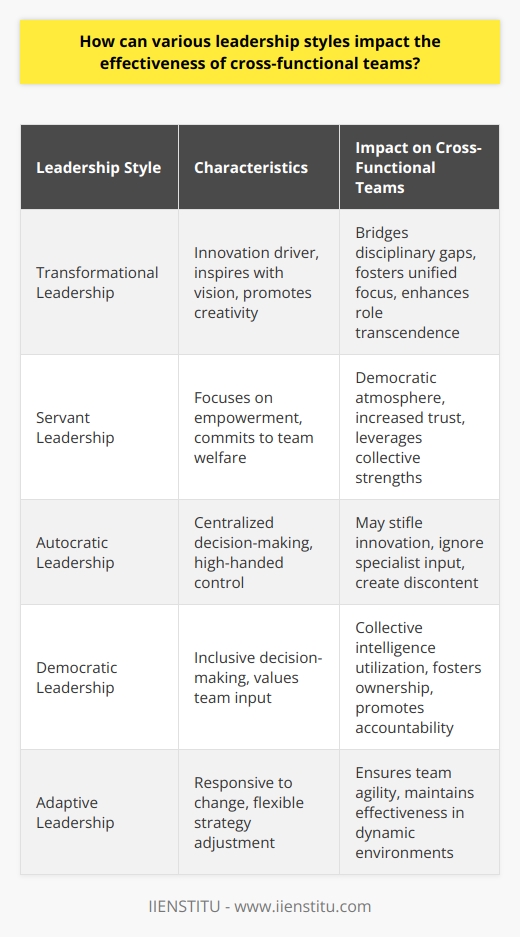
What role does organizational culture play in the success of cross-functional project implementation?
Role of Organizational Culture in Success
Organizational culture significantly contributes to the successful implementation of cross-functional projects. A supportive, open, and collaborative culture is essential in fostering an environment where cross-functional teams can thrive. Shared values, clear communication channels, and a commitment to continuous improvement can foster increased cooperation, trust, and commitment among team members.
Value Congruence
A crucial factor in achieving success with cross-functional projects is value congruence among team members. When employees have a shared set of values and beliefs, they are more likely to be committed to the project and work more effectively toward common goals. Additionally, a value-centric organizational culture is conducive to mutual understanding and trust, which are critical components of successful collaboration.
Clear Communication Channels
Effective communication plays a vital role in setting and managing expectations in cross-functional projects. Strong communication channels not only facilitate coordination among team members but also help in articulating goals, vision, progress, and potential roadblocks. A transparent and efficient communication culture contributes to the reduction of misunderstandings and misinterpretations, contributing to better collaboration across functional divisions.
Commitment to Continuous Improvement
An organizational culture that embraces continuous improvement and innovation is better positioned to tackle complex cross-functional projects. Encouraging a learning environment that supports the development and sharing of expertise instills a culture of knowledge and skill-building. This supports the implementation of more effective and efficient strategies for achieving project goals.
Promoting Collaborative Environment
A collaborative work environment empowers cross-functional teams to reap the benefits of diverse expertise and differing perspectives. By encouraging collaboration and embracing a culture where open dialogue and sharing of insights are encouraged, employees become more engaged and committed to the project. This not only leads to the generation of innovative ideas but also contributes to a more harmonious and motivated team.
In summary, organizational culture plays a vital role in facilitating the success of cross-functional projects. By fostering shared values, open communication, continuous improvement, and a collaborative environment, organizations can effectively navigate the complexities of cross-functional projects and achieve their goals. Therefore, investing in building strong and supportive organizational culture is essential for the successful implementation of cross-functional project initiatives.
